Choosing the right thread for sashiko embroidery is a crucial decision that impacts this traditional Japanese craft’s authenticity and visual appeal.
Sashiko, known for its geometric patterns and bold lines, demands a thread that complements its intricate stitching technique.
In this exploration, we delve into what thread You use for sashiko embroidery to guide enthusiasts in selecting the perfect thread for their sashiko projects.
Whether opting for traditional sashiko thread or exploring alternatives like perle cotton, linen, or silk, the choice significantly influences the final outcome, capturing the essence of this timeless art form.
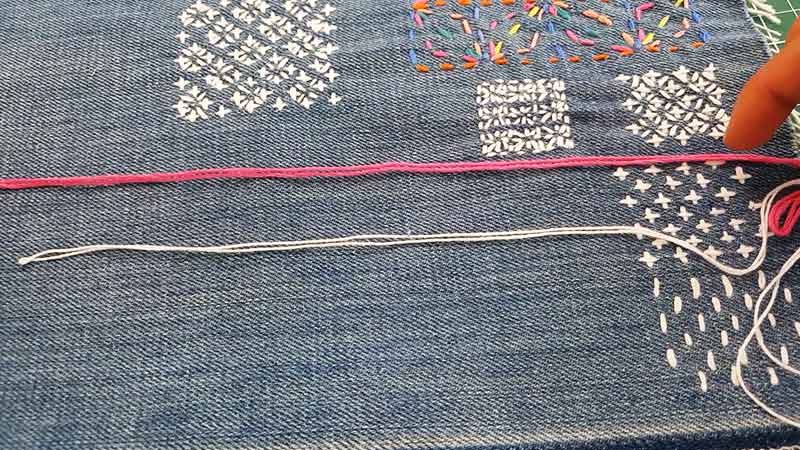
Can I Use Embroidery Thread For Sashiko?
While embroidery thread and sashiko thread share similarities, using embroidery thread for sashiko requires careful consideration.
Sashiko, a traditional Japanese embroidery technique, typically employs thicker and more robust threads to create its distinctive geometric patterns.
While embroidery thread can be visually appealing, it may lack the durability and thickness needed for authentic sashiko stitching.
Sashiko thread’s unique characteristics, including its twisted structure and sturdiness, contribute to the technique’s traditional aesthetic and ensure the longevity of the stitches.
If opting for embroidery thread, choose a thicker variety and be mindful of potential wear and tear over time.
However, for an authentic and lasting result, using a specialized sashiko thread is recommended to capture the essence of this centuries-old craft.
What Thread Do You Use For Sashiko Embroidery?
Selecting the right thread is crucial for achieving the authentic look and durability in sashiko embroidery. Various threads cater to different preferences, ensuring you capture the essence of this traditional Japanese craft.
Here are seven kinds of threads recommended for sashiko:
Traditional Sashiko Thread
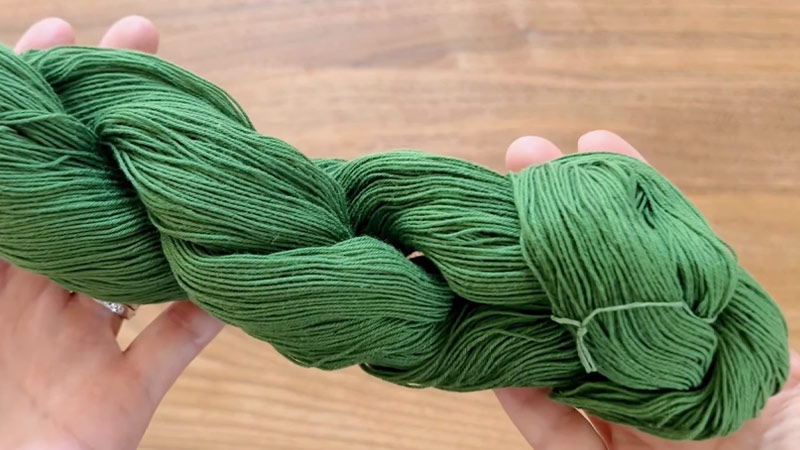
Authentic sashiko thread, specifically designed for this craft, is a heavyweight, tightly twisted thread. Its thickness and sturdiness ensure the characteristic bold lines and durability required for traditional sashiko stitching.
Perle Cotton Thread
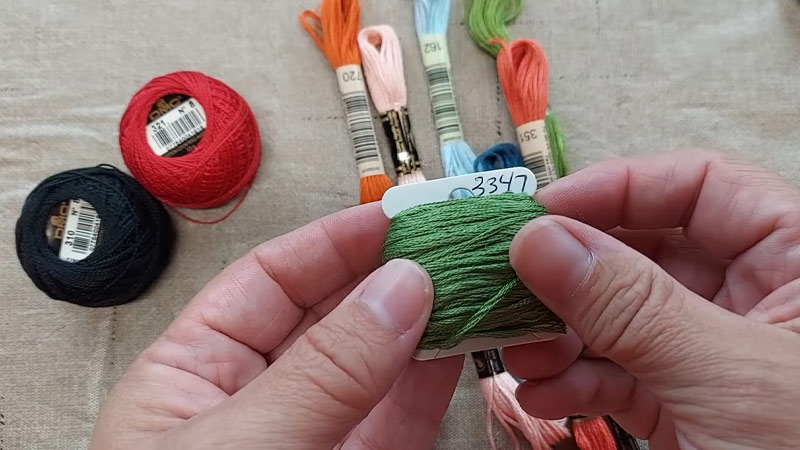
Perle cotton thread, known for its thickness and sheen, is popular for contemporary sashiko. It comes in various thicknesses, allowing for versatility in creating intricate patterns while maintaining the desired texture.
Embroidery Floss
Dividing embroidery floss strands to achieve the desired thickness is a common practice for sashiko. It allows for a wide range of color choices and is suitable for smaller, detailed sashiko projects.
Sashiko Silk Thread
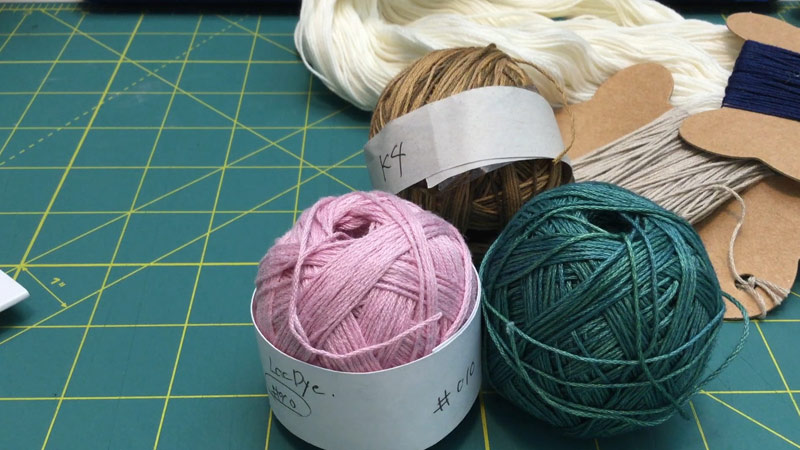
Sashiko silk thread offers a smooth and glossy finish for a luxurious touch. While not as traditional as cotton threads, sashiko silk thread adds elegance to your stitching projects.
Linen Thread
Linen thread complements the natural feel of fabric, providing a rustic and textured appearance. Its durability makes it a suitable choice for sashiko, especially when working on items that will see frequent use.
Variegated Sashiko Thread
Variegated threads add visual interest to sashiko projects, creating a gradient effect. These threads bring a contemporary twist to traditional designs, making them ideal for modern sashiko interpretations.
Indigo-Dyed Sashiko Thread
Indigo-dyed threads pay homage to sashiko’s Japanese roots. These threads often come in deep indigo hues, allowing you to capture the traditional aesthetic of sashiko while adding a touch of cultural authenticity to your embroidery.
When deciding what thread to use for sashiko, consider the project’s size, intricacy, and desired visual impact. Each type of thread offers unique characteristics, ensuring a fulfilling and visually striking sashiko embroidery experience.
Sashiko Thread Vs Embroidery Thread
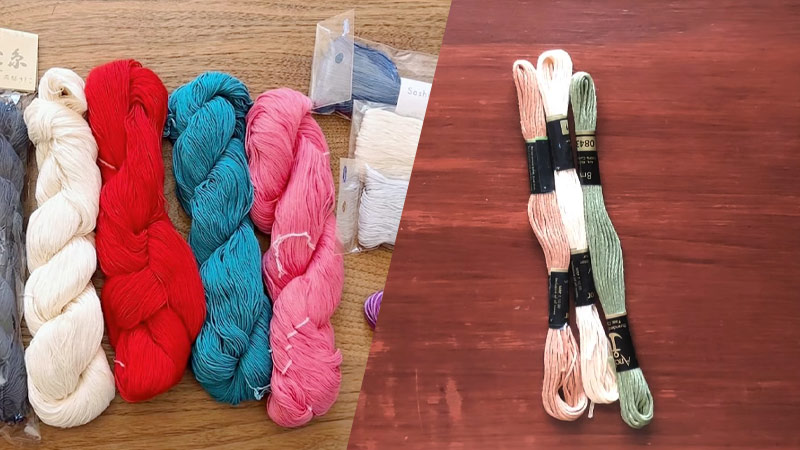
Here’s some difference between sashiko thread and embroidery thread:
| Thread Type | Sashiko Thread | Embroidery Thread |
| Material | Cotton, tightly twisted for durability | Varied materials (cotton, polyester, rayon), versatility |
| Thickness | Heavyweight, for bold lines and durability | Range of thickness, adaptable to various embroidery sizes |
| Twist | Varies may have looser twist for smoother embroidery | Varies may have a looser twist for smoother embroidery |
| Usage | Traditional Japanese sashiko stitching | Versatile, used in a wide range of embroidery projects |
| Colors | Limited traditional colors | Extensive color options for diverse embroidery styles |
| Aesthetic | Traditional, rustic, and durable | It can offer a glossy or smooth finish depending on the material |
| Projects | Ideal for authentic sashiko patterns | It can offer a glossy or smooth finish depending on material |
Comparison Overview
Sashiko thread and embroidery thread serve different purposes in the realm of stitching. With its tight twist and heavyweight, Sashiko thread is designed for durability and traditional Japanese sashiko stitching, offering a rustic and authentic look.
On the other hand, embroidery thread, available in various materials and thicknesses, is versatile and adaptable to a broad spectrum of embroidery projects, providing a glossy finish if desired.
Their choice depends on the specific aesthetic, project requirements, and the desired visual impact.
Sashiko Thread Alternative
When exploring alternatives for thread for sashiko, it’s essential to consider various options that provide both durability and authenticity for traditional sashiko stitching.
Here are seven alternatives to the sashiko thread:
Perle Cotton Thread
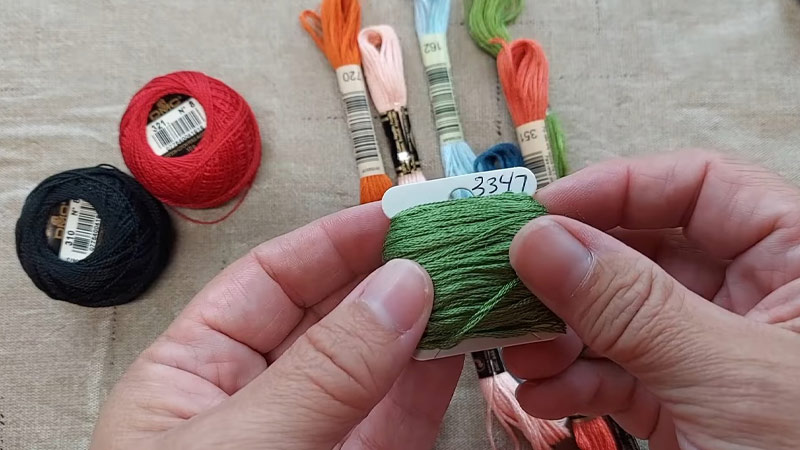
Perle cotton, known for its thickness and sheen, is a versatile sashiko alternative. With a smooth texture and available in various thicknesses, it allows for intricate stitching while offering a contemporary touch.
Linen Thread
With its natural and rustic appeal, linen thread provides an excellent alternative for sashiko. Its durability and textured finish make it suitable for capturing the essence of traditional Japanese stitching.
Embroidery Floss
Dividing embroidery floss strands enables the creation of thicker threads, making it a practical alternative for sashiko. This option offers many colors, allowing for creative expression in your sashiko projects.
Sashiko Silk Thread
Sashiko silk thread is an elegant alternative for those seeking a luxurious touch. A smooth and glossy finish adds sophistication to your sashiko stitching, creating a unique blend of tradition and refinement.
Denim Thread
Recycle old denim by unraveling the seams to obtain denim thread. Its strength and slightly textured appearance make it a sustainable and fitting alternative for sashiko, adding an interesting visual element to your stitching.
Variegated Embroidery Thread
With their color-changing qualities, varied threads offer a modern twist to traditional sashiko. The gradient effect adds visual interest, making it a contemporary alternative for unique and vibrant sashiko projects.
Japanese Embroidery Thread
Exploring threads specifically designed for Japanese embroidery can be an alternative to traditional sashiko thread. These threads often capture the essence of Japanese stitching techniques, providing authenticity in your sashiko projects.
When choosing an alternative thread for sashiko, consider the desired aesthetic, project size, and personal preferences. Each alternative offers a distinctive character, allowing you to infuse creativity into your sashiko stitching while maintaining the essence of this timeless craft.
FAQs
Can I use embroidery thread for Sashiko?
While possible, using embroidery thread requires careful consideration. Sashiko threads are generally thicker and sturdier, providing the necessary strength for traditional patterns.
If opting for embroidery thread, choose a thicker variety to maintain the desired texture and durability.
What is Perle cotton thread, and is it suitable for Sashiko?
Perle cotton, known for its thickness and sheen, is a versatile alternative for Sashiko. It allows for intricate stitching, adding a contemporary touch to traditional patterns.
Is linen thread a good choice for Sashiko?
Yes, linen thread serves as an excellent alternative for Sashiko. Its natural, rustic appeal and durability make it suitable for capturing the essence of traditional Japanese stitching.
Can I use silk thread for Sashiko embroidery?
Certainly, silk thread can add a luxurious touch to Sashiko. Its smooth and glossy finish brings sophistication to the stitching, creating a unique blend of tradition and refinement.
Are there alternatives to traditional Sashiko thread?
Indeed, several alternatives can be used for Sashiko, including perle cotton, linen, silk, and even recycled denim threads. Each offers unique characteristics, allowing enthusiasts to tailor their Sashiko projects to their preferences.
Conclusion
The choice of thread for Sashiko embroidery was a pivotal decision that influenced the outcome of this revered Japanese needlework. The exploration of specialized Sashiko threads emphasizes the importance of authenticity and durability in preserving the essence of this traditional craft.
Whether you opt for traditional hemp or contemporary cotton threads, the selected material contributes to your Sashiko creations’ longevity and visual appeal.
As you delve into the artistry of Sashiko embroidery, choosing the right thread becomes not just a practical consideration but a homage to the rich heritage of this meticulous and beautiful needlework technique.
With the perfect thread in hand, your Sashiko projects can truly become timeless masterpieces that showcase the art’s cultural significance and enduring beauty.
Leave a Reply